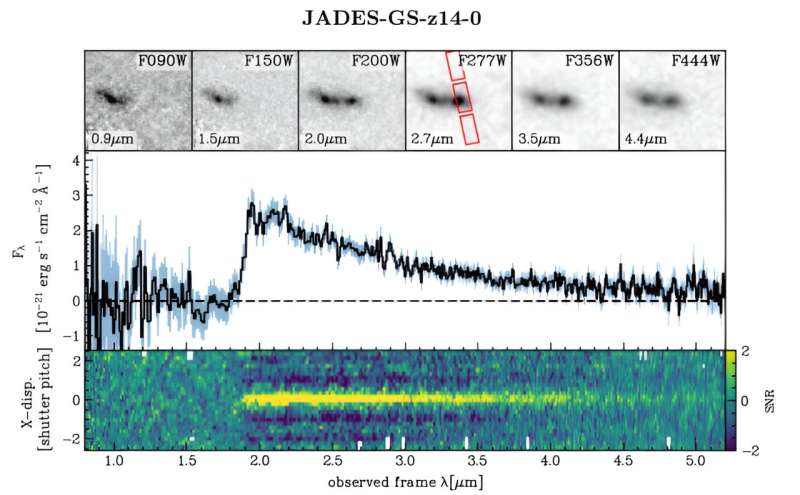August 1, 2024 report
This article has been reviewed according to Science X's editorial process and policies. Editors have highlighted the following attributes while ensuring the content's credibility:
fact-checked
peer-reviewed publication
trusted source
proofread
JWST imagery shows light from one of the earliest galaxies is due to continuing bursts from star formations

An international team of astronomers and astrophysicists studying data and imagery received from the James Webb Space Telescope (JWST) has found that light emitted from one of the earliest galaxies identified thus far, is due to continuing bursts from star formations.
In their paper published in Nature, the group describes how they confirmed, using redshift measurements, that light from the galaxy JADES-GS-z14-0, was not produced by a black hole but was instead due to emanations from young stars that formed millions of years after the Big Bang.
One of the primary missions of the JWST is to look for and study the oldest possible galaxies that can be observed. Doing so, it was thought, would help to better understand how the galaxy and its components evolved into their present form.
As part of that effort, research teams have been conducting what they have named the JWST Advanced Deep Extragalactic Survey (JADES)—in recent research, two galaxies have been found and identified as some of the oldest ever observed—both are believed to have come into existence approximately 300 million years following the Big Bang.
Called JADES-GS-z14-1 and JADES-GS-z14-0, the two galaxies have been scrutinized by several teams, each looking to learn more about how they came to exist after such a relatively short span of time.
In this new study, the researchers investigated why one of the galaxies—JADES-GS-z14-0—was emitting so much light. They studied 10 hours of near infrared spectrographic data received from JWST, focusing most specifically on redshift measurements and were able to confirm that the galaxy is the earliest ever observed.
The data also showed that the superbright light emitted by the galaxy is not coming from a black hole at its center. Instead, it is coming from a halo of young stars that surround its core. Such a finding, the team notes, suggests that the light is being created through the bursting of new star creation, which, they have calculated, has been going on since just 200 million years after the Big Bang.
It also suggests, the team notes, that the galaxy is really big. Another surprising find is that it contains more dust and oxygen than was expected, suggesting that the galaxy has a long history of stars coming into existence and dying.
More information: Stefano Carniani et al, Spectroscopic confirmation of two luminous galaxies at a redshift of 14, Nature (2024). DOI: 10.1038/s41586-024-07860-9 . On arXiv: DOI: 10.48550/arxiv.2405.18485
© 2024 Science X Network




















